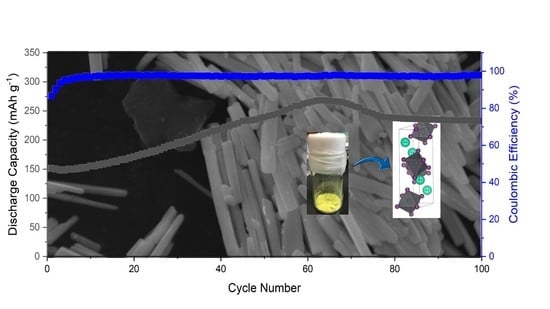Electrochemical Performance of Orthorhombic CsPbI3 Perovskite in Li-Ion Batteries
Abstract
:1. Introduction
2. Experimental Section
2.1. Materials Preparation
2.2. Material Characterization
2.3. Electrochemical Measurement
2.4. Theoretical Treatment
3. Results and Discussion
4. Conclusions
Supplementary Materials
Author Contributions
Funding
Institutional Review Board Statement
Informed Consent Statement
Data Availability Statement
Conflicts of Interest
References
- Dunn, B.; Kamath, H.; Tarascon, J.-M. Electrical Energy Storage for the Grid: A Battery of Choices. Science 2011, 334, 928–935. [Google Scholar] [CrossRef] [PubMed] [Green Version]
- Chu, S.; Cui, Y.; Liu, N. The Path Towards Sustainable Energy. Nat. Mater. 2017, 16, 16–22. [Google Scholar] [CrossRef] [PubMed]
- Liu, D.-H.; Bai, Z.; Li, M.; Yu, A.; Luo, D.; Liu, W.; Yang, L.; Lu, J.; Amine, K.; Chen, Z. Developing High Safety Li-Metal Anodes for Future High-Energy Li-Metal Batteries: Strategies and Perspectives. Chem. Soc. Rev. 2020, 49, 5407–5445. [Google Scholar] [CrossRef]
- Shen, X.; Li, Y.; Qian, T.; Liu, J.; Zhou, J.; Yan, C.; Goodenough, J.B. Lithium Anode Stable in Air for Low-Cost Fabrication of a Dendrite-Free Lithium Battery. Nat. Commun. 2019, 10, 900. [Google Scholar] [CrossRef] [PubMed] [Green Version]
- Xu, W.; Wang, J.; Ding, F.; Chen, X.; Nasybulin, E.; Zhang, Y.; Zhang, J.-G. Lithium Metal Anodes for Rechargeable Batteries. Energy Environ. Sci. 2014, 7, 513–537. [Google Scholar] [CrossRef]
- Dai, H.; Gu, X.; Dong, J.; Wang, C.; Lai, C.; Sun, S. Stabilizing Lithium Metal Anode by Octaphenyl Polyoxyethylene-Lithium Complexation. Nat. Commun. 2020, 11, 643. [Google Scholar] [CrossRef] [PubMed] [Green Version]
- Chen, K.-H.; Namkoong, M.J.; Goel, V.; Yang, C.; Kazemiabnavi, S.; Mortuza, S.; Kazyak, E.; Mazumder, J.; Thornton, K.; Sakamoto, J. Efficient Fast-Charging of Lithium-Ion Batteries Enabled by Laser-Patterned Three-Dimensional Graphite Anode Architectures. J. Power Sources 2020, 471, 228475. [Google Scholar] [CrossRef]
- Odziomek, M.; Chaput, F.; Rutkowska, A.; Świerczek, K.; Olszewska, D.; Sitarz, M.; Lerouge, F.; Parola, S. Hierarchically Structured Lithium Titanate for Ultrafast Charging in Long-Life High Capacity Batteries. Nat. Commun. 2017, 8, 15636. [Google Scholar] [CrossRef] [PubMed]
- Fu, L.; Endo, K.; Sekine, K.; Takamura, T.; Wu, Y.; Wu, H. Studies on Capacity Fading Mechanism of Graphite Anode for Li-Ion Battery. J. Power Sources 2006, 162, 663–666. [Google Scholar] [CrossRef]
- Amine, K.; Belharouak, I.; Chen, Z.; Tran, T.; Yumoto, H.; Ota, N.; Myung, S.T.; Sun, Y.K. Nanostructured Anode Material for High-Power Battery System in Electric Vehicles. Adv. Mater. 2010, 22, 3052–3057. [Google Scholar] [CrossRef]
- Yi, T.-F.; Liu, H.; Zhu, Y.-R.; Jiang, L.-J.; Xie, Y.; Zhu, R.-S. Improving the High Rate Performance of Li4ti5o12 through Divalent Zinc Substitution. J. Power Sources 2012, 215, 258–265. [Google Scholar] [CrossRef]
- Xue, X.; Yan, H.; Fu, Y. Preparation of Pure and Metal-Doped Li4ti5o12 Composites and Their Lithium-Storage Performances for Lithium-Ion Batteries. Solid State Ion. 2019, 335, 1–6. [Google Scholar] [CrossRef]
- Cho, J. Porous Si Anode Materials for Lithium Rechargeable Batteries. J. Mater. Chem. 2010, 20, 4009–4014. [Google Scholar] [CrossRef]
- McDowell, M.T.; Lee, S.W.; Wang, C.; Cui, Y. The Effect of Metallic Coatings and Crystallinity on the Volume Expansion of Silicon During Electrochemical Lithiation/Delithiation. Nano Energy 2012, 1, 401–410. [Google Scholar] [CrossRef]
- Hassan, M.F.; Guo, Z.; Chen, Z.; Liu, H.-K. Carbon-Coated Moo3 Nanobelts as Anode Materials for Lithium-Ion Batteries. J. Power Sources 2010, 195, 2372–2376. [Google Scholar] [CrossRef]
- Qiao, H.; Xiao, L.; Zhang, L. Phosphatization: A Promising Approach to Enhance the Performance of Mesoporous Tio2 Anode for Lithium Ion Batteries. Electrochem. Commun. 2008, 10, 616–620. [Google Scholar] [CrossRef]
- Kashale, A.A.; Ghule, K.A.; Gattu, K.P.; Ingole, V.H.; Dhanayat, S.S.; Sharma, R.; Ling, Y.-C.; Chang, J.-Y.; Vadiyar, M.M.; Ghule, A.V. Annealing Atmosphere Dependant Properties of Biosynthesized Tio 2 Anode for Lithium Ion Battery Application. J. Mater. Sci. Mater. Electron. 2017, 28, 1472–1479. [Google Scholar] [CrossRef]
- Hwang, H.; Kim, H.; Cho, J. Mos2 Nanoplates Consisting of Disordered Graphene-Like Layers for High Rate Lithium Battery Anode Materials. Nano Lett. 2011, 11, 4826–4830. [Google Scholar] [CrossRef] [PubMed]
- Zhang, D.; Mai, Y.; Xiang, J.; Xia, X.; Qiao, Y.; Tu, J. Fes2/C Composite as an Anode for Lithium Ion Batteries with Enhanced Reversible Capacity. J. Power Sources 2012, 217, 229–235. [Google Scholar] [CrossRef]
- Zhou, Y.; Yan, D.; Xu, H.; Feng, J.; Jiang, X.; Yue, J.; Yang, J.; Qian, Y. Hollow Nanospheres of Mesoporous Co9s8 as a High-Capacity and Long-Life Anode for Advanced Lithium Ion Batteries. Nano Energy 2015, 12, 528–537. [Google Scholar] [CrossRef]
- Jing, Y.; Zhou, Z.; Cabrera, C.R.; Chen, Z. Metallic Vs2 Monolayer: A Promising 2d Anode Material for Lithium Ion Batteries. J. Phys. Chem. C 2013, 117, 25409–25413. [Google Scholar] [CrossRef]
- Ming, F.; Liang, H.; Lei, Y.; Kandambeth, S.; Eddaoudi, M.; Alshareef, H.N. Layered Mg X V2o5· N H2o as Cathode Material for High-Performance Aqueous Zinc Ion Batteries. ACS Energy Lett. 2018, 3, 2602–2609. [Google Scholar] [CrossRef] [Green Version]
- Wang, Z.-T.; Wang, R.-C.; Tang, L.-B.; Li, Y.-J.; Mao, J.; Dai, K.-H.; He, Z.-J.; Zheng, J.-C. A Sandwich-Like Ti3c2@ Vo2 Composite Synthesized by a Hydrothermal Method for Lithium Storage. Solid State Ion. 2021, 369, 115714. [Google Scholar] [CrossRef]
- Wang, P.; Zhang, X.; Zhou, Y.; Jiang, Q.; Ye, Q.; Chu, Z.; Li, X.; Yang, X.; Yin, Z.; You, J. Solvent-Controlled Growth of Inorganic Perovskite Films in Dry Environment for Efficient and Stable Solar Cells. Nat. Commun. 2018, 9, 2225. [Google Scholar] [CrossRef] [PubMed]
- Tan, Z.-K.; Moghaddam, R.S.; Lai, M.L.; Docampo, P.; Higler, R.; Deschler, F.; Price, M.; Sadhanala, A.; Pazos, L.M.; Credgington, D. Bright Light-Emitting Diodes Based on Organometal Halide Perovskite. Nat. Nanotechnol. 2014, 9, 687–692. [Google Scholar] [CrossRef] [PubMed]
- Xia, H.-R.; Li, J.; Sun, W.-T.; Peng, L.-M. Organohalide Lead Perovskite Based Photodetectors with Much Enhanced Performance. Chem. Commun. 2014, 50, 13695–13697. [Google Scholar] [CrossRef]
- Dou, L.; Yang, Y.M.; You, J.; Hong, Z.; Chang, W.-H.; Li, G.; Yang, Y. Solution-Processed Hybrid Perovskite Photodetectors with High Detectivity. Nat. Commun. 2014, 5, 5404. [Google Scholar] [CrossRef]
- Zhang, Q.; Ha, S.T.; Liu, X.; Sum, T.C.; Xiong, Q. Room-Temperature near-Infrared High-Q Perovskite Whispering-Gallery Planar Nanolasers. Nano Lett. 2014, 14, 5995–6001. [Google Scholar] [CrossRef]
- De Bastiani, M.; Saidaminov, M.I.; Dursun, I.; Sinatra, L.; Peng, W.; Buttner, U.; Mohammed, O.F.; Bakr, O.M. Thermochromic Perovskite Inks for Reversible Smart Window Applications. Chem. Mater. 2017, 29, 3367–3370. [Google Scholar] [CrossRef]
- Kostopoulou, A.; Kymakis, E.; Stratakis, E. Perovskite Nanostructures for Photovoltaic and Energy Storage Devices. J. Mater. Chem. A 2018, 6, 9765–9798. [Google Scholar] [CrossRef]
- Xia, H.-R.; Sun, W.-T.; Peng, L.-M. Hydrothermal Synthesis of Organometal Halide Perovskites for Li-Ion Batteries. Chem. Commun. 2015, 51, 13787–13790. [Google Scholar] [CrossRef]
- Jaffe, A.; Karunadasa, H.I. Lithium Cycling in a Self-Assembled Copper Chloride–Polyether Hybrid Electrode. Inorg. Chem. 2014, 53, 6494–6496. [Google Scholar] [CrossRef]
- Lira-Cantú, M.; Gómez-Romero, P. Electrochemical and Chemical Syntheses of the Hybrid Organic—Inorganic Electroactive Material Formed by Phosphomolybdate and Polyaniline. Application as Cation-Insertion Electrodes. Chem. Mater. 1998, 10, 698–704. [Google Scholar] [CrossRef] [Green Version]
- Pal, P.; Ghosh, A. Three-Dimensional Cs Pb Cl 3 Perovskite Anode for Quasi-Solid-State Li-Ion and Dual-Ion Batteries: Mechanism of Li+ Conversion Process in Perovskite. Phys. Rev. Appl. 2020, 14, 064010. [Google Scholar] [CrossRef]
- Pandey, P.; Sharma, N.; Panchal, R.A.; Gosavi, S.; Ogale, S. Realization of High Capacity and Cycling Stability in Pb-Free a 2 Cubr 4 (a= Ch 3 Nh 3/Cs, 2d/3d) Perovskite-Based Li-Ion Battery Anodes. ChemSusChem 2019, 12, 3742–3746. [Google Scholar] [CrossRef] [PubMed]
- Kostopoulou, A.; Vernardou, D.; Makri, D.; Brintakis, K.; Savva, K.; Stratakis, E. Highly Stable Metal Halide Perovskite Microcube Anodes for Lithium-Air Batteries. J. Power Sources Adv. 2020, 3, 100015. [Google Scholar] [CrossRef]
- Kostopoulou, A.; Vernardou, D.; Savva, K.; Stratakis, E. All-Inorganic Lead Halide Perovskite Nanohexagons for High Performance Air-Stable Lithium Batteries. Nanoscale 2019, 11, 882–889. [Google Scholar] [CrossRef] [PubMed]
- Kaisar, N.; Singh, A.; Yang, P.-Y.; Chen, Y.-T.; Li, S.; Pao, C.-W.; Jou, S.; Chu, C.-W. Long-Lifespan Lithium–Metal Batteries Obtained Using a Perovskite Intercalation Layer to Stabilize the Lithium Electrode. J. Mater. Chem. A 2020, 8, 9137–9145. [Google Scholar] [CrossRef]
- Su, K.; Chi, P.; Paul, T.; Chung, C.; Chen, W.; Su, Y.; Wu, P.; Su, C.; Wu, M. Lithiation and Delithiation Induced Magnetic Switching and Electrochemical Studies in A-Lifeo2 Based Li Ion Battery. Mater. Today Phys. 2021, 18, 100373. [Google Scholar] [CrossRef]
- Paul, T.; Chi, P.; Wu, P.M.; Wu, M. Computation of Distribution of Relaxation Times by Tikhonov Regularization for Li Ion Batteries: Usage of L-Curve Method. Sci. Rep. 2021, 11, 12624. [Google Scholar] [CrossRef]
- Susai, F.A.; Talianker, M.; Liu, J.; Paul, T.; Grinblat, Y.; Erickson, E.; Noked, M.; Burstein, L.; Frenkel, A.I.; Tsur, Y. Electrochemical Activation of Li2mno3 Electrodes at 0° C and Its Impact on the Subsequent Performance at Higher Temperatures. Materials 2020, 13, 4388. [Google Scholar] [CrossRef] [PubMed]
- Paul, T. Modeling of the Impedance Data of Gadolinia Doped Ceria Based Actuators: A Distribution Function of Relaxation Times and Machine Learning Approach. J. Phys. D Appl. Phys. 2020, 53, 415503. [Google Scholar] [CrossRef]
- Mishuk, E.; Ushakov, A.; Makagon, E.; Cohen, S.R.; Wachtel, E.; Paul, T.; Tsur, Y.; Shur, V.Y.; Kholkin, A.; Lubomirsky, I. Electro-Chemomechanical Contribution to Mechanical Actuation in Gd-Doped Ceria Membranes. Adv. Mater. Interfaces 2019, 6, 1801592. [Google Scholar] [CrossRef]
- Paul, T.; Tsur, Y. Effect of Isovalent Doping on Grain Boundary Conductivity for La2mo2o9 Oxide Ion Conductor: A Distribution Function of Relaxation Times Approach. Solid State Ion. 2018, 323, 37–43. [Google Scholar] [CrossRef]
- Paul, T.; Tsur, Y. Influence of Isovalent ‘W’substitutions on the Structure and Electrical Properties of La2mo2o9 Electrolyte for Intermediate-Temperature Solid Oxide Fuel Cells. Ceramics 2021, 4, 502–515. [Google Scholar] [CrossRef]
- Rodríguez-Carvajal, J. Recent Advances in Magnetic Structure Determination by Neutron Powder Diffraction. Phys. B 1993, 192, 55–69. [Google Scholar] [CrossRef]
- Momma, K.; Izumi, F. Vesta 3 for Three-Dimensional Visualization of Crystal, Volumetric and Morphology Data. J. Appl. Crystallogr. 2011, 44, 1272–1276. [Google Scholar] [CrossRef]
- Chiromawa, I.M.; Shaari, A.; Razali, R.; Ahams, S.T.; Abdullahi, M. Ab Initio Investigation of the Structure and Electronic Properties of Normal Spinel Fe2sio4. Malays. J. Fundam. Appl. Sci. 2021, 17, 195–201. [Google Scholar] [CrossRef]
- Giannozzi, P.; Andreussi, O.; Brumme, T.; Bunau, O.; Nardelli, M.B.; Calandra, M.; Car, R.; Cavazzoni, C.; Ceresoli, D.; Cococcioni, M. Advanced Capabilities for Materials Modelling with Quantum Espresso. J. Phys. Condens. Matter 2017, 29, 465901. [Google Scholar] [CrossRef] [Green Version]
- Yadav, S.; Grinberg, I. First-Principles Study of the Composition, Cation Arrangement, and Local Structure in High-Performance Bi (Me 3+) O3–Pbtio3 (Me 3+= Ga, Sc, in) Ferroelectric Solid Solutions. J. Appl. Phys. 2021, 129, 174101. [Google Scholar] [CrossRef]
- Lai, M.; Kong, Q.; Bischak, C.G.; Yu, Y.; Dou, L.; Eaton, S.W.; Ginsberg, N.S.; Yang, P. Structural, Optical, and Electrical Properties of Phase-Controlled Cesium Lead Iodide Nanowires. Nano Res. 2017, 10, 1107–1114. [Google Scholar] [CrossRef] [Green Version]
- Marronnier, A.; Roma, G.; Boyer-Richard, S.; Pedesseau, L.; Jancu, J.-M.; Bonnassieux, Y.; Katan, C.; Stoumpos, C.C.; Kanatzidis, M.G.; Even, J. Anharmonicity and Disorder in the Black Phases of Cesium Lead Iodide Used for Stable Inorganic Perovskite Solar Cells. ACS Nano 2018, 12, 3477–3486. [Google Scholar] [CrossRef]
- Wang, K.; Jin, Z.; Liang, L.; Bian, H.; Bai, D.; Wang, H.; Zhang, J.; Wang, Q.; Liu, S. All-Inorganic Cesium Lead Iodide Perovskite Solar Cells with Stabilized Efficiency Beyond 15%. Nat. Commun. 2018, 9, 4544. [Google Scholar] [CrossRef] [PubMed] [Green Version]
- Liu, X.; Tang, Z.; Li, Q.; Zhang, Q.; Yu, X.; Gu, L. Symmetry-Induced Emergent Electrochemical Properties for Rechargeable Batteries. Cell Rep. Phys. Sci. 2020, 100066. [Google Scholar] [CrossRef]
- Jiang, Q.; Chen, M.; Li, J.; Wang, M.; Zeng, X.; Besara, T.; Lu, J.; Xin, Y.; Shan, X.; Pan, B. Electrochemical Doping of Halide Perovskites with Ion Intercalation. ACS Nano 2017, 11, 1073–1079. [Google Scholar] [CrossRef] [PubMed]
- Illig, J.; Ender, M.; Chrobak, T.; Schmidt, J.P.; Klotz, D.; Ivers-Tiffée, E. Separation of Charge Transfer and Contact Resistance in Lifepo4-Cathodes by Impedance Modeling. J. Electrochem. Soc. 2012, 159, A952. [Google Scholar] [CrossRef]
- Lu, H.; Guo, Q.; Fan, Q.; Xue, L.; Lu, X.; Zan, F.; Xia, H. Cobalt Sulfide Quantum Dot Embedded in Nitrogen/Sulfur-Doped Carbon Nanosheets as a Polysulfide Barrier in Li-S Batteries. J. Alloy. Compd. 2021, 870, 159341. [Google Scholar] [CrossRef]
- Brik, M.; Kityk, I.; Denysyuk, N.; Khyzhun, O.; Levkovets, S.; Parasyuk, O.; Fedorchuk, A.; Myronchuk, G. Specific Features of the Electronic Structure of a Novel Ternary Tl 3 Pbi 5 Optoelectronic Material. Phys. Chem. Chem. Phys. 2014, 16, 12838–12847. [Google Scholar] [CrossRef]
- Zhang, M.; Tian, Z.-Q.; Zhu, D.-L.; He, H.; Guo, S.-W.; Chen, Z.-L.; Pang, D.-W. Stable Cspbbr 3 Perovskite Quantum Dots with High Fluorescence Quantum Yields. New J. Chem. 2018, 42, 9496–9500. [Google Scholar] [CrossRef]
- Ziv, B.; Borgel, V.; Aurbach, D.; Kim, J.-H.; Xiao, X.; Powell, B.R. Investigation of the Reasons for Capacity Fading in Li-Ion Battery Cells. J. Electrochem. Soc. 2014, 161, A1672. [Google Scholar] [CrossRef]
- Momose, H.; Honbo, H.; Takeuchi, S.; Nishimura, K.; Horiba, T.; Muranaka, Y.; Kozono, Y.; Miyadera, H. X-Ray Photoelectron Spectroscopy Analyses of Lithium Intercalation and Alloying Reactions on Graphite Electrodes. J. Power Sources 1997, 68, 208–211. [Google Scholar] [CrossRef]
- Wang, Q.; Yang, T.; Wang, H.; Zhang, J.; Guo, X.; Yang, Z.; Lu, S.; Qin, W. Morphological and Chemical Tuning of Lead Halide Perovskite Mesocrystals as Long-Life Anode Materials in Lithium-Ion Batteries. CrystEngComm 2019, 21, 1048–1059. [Google Scholar] [CrossRef]
- Martos, M.; Morales, J.; Sanchez, L. Lead-Based Systems as Suitable Anode Materials for Li-Ion Batteries. Electrochim. Acta 2003, 48, 615–621. [Google Scholar] [CrossRef] [Green Version]
- Han, T.H.; Lee, J.W.; Choi, Y.J.; Choi, C.; Tan, S.; Lee, S.J.; Zhao, Y.; Huang, Y.; Kim, D.; Yang, Y. Surface-2d/Bulk-3d Heterophased Perovskite Nanograins for Long-Term-Stable Light-Emitting Diodes. Adv. Mater. 2020, 32, 1905674. [Google Scholar] [CrossRef]
- Yue, L.; Tang, J.; Li, F.; Xu, N.; Zhang, F.; Zhang, Q.; Guan, R.; Hong, J.; Zhang, W. Enhanced Reversible Lithium Storage in Ultrathin W18o49 Nanowires Entwined Si Composite Anode. Mater. Lett. 2017, 187, 118–122. [Google Scholar] [CrossRef]
- Chen, Z.; Ye, K.; Li, M.; Zhao, S.; Luo, J.; Wu, B. Lithiation Mechanism of W18o49 Anode Material for Lithium-Ion Batteries: Experiment and First-Principles Calculations. J. Electroanal. Chem. 2021, 880, 114885. [Google Scholar] [CrossRef]
- Smith, A.; Dahn, J. Delta Differential Capacity Analysis. J. Electrochem. Soc. 2012, 159, A290. [Google Scholar] [CrossRef]
- Korthauer, R. Lithium-Ion Batteries: Basics and Applications; Springer: Berlin, Germany, 2018. [Google Scholar]
- Zhang, Y.; Wang, N.; Bai, Z. The Progress of Cobalt-Based Anode Materials for Lithium Ion Batteries and Sodium Ion Batteries. Appl. Sci. 2020, 10, 3098. [Google Scholar] [CrossRef]
- Liu, Y.; Zhang, L.; Zhao, Y.; Shen, T.; Yan, X.; Yu, C.; Wang, H.; Zeng, H. Novel Plasma-Engineered Mos2 Nanosheets for Superior Lithium-Ion Batteries. J. Alloy. Compd. 2019, 787, 996–1003. [Google Scholar] [CrossRef]
- Wang, P.; Tian, J.; Hu, J.; Zhou, X.; Li, C. Supernormal Conversion Anode Consisting of High-Density Mos2 Bubbles Wrapped in Thin Carbon Network by Self-Sulfuration of Polyoxometalate Complex. ACS Nano 2017, 11, 7390–7400. [Google Scholar] [CrossRef]
- Tang, J.; Lugo, C.E.Z.; Guzmán, S.F.A.; Daniel, G.; Kessler, V.G.; Seisenbaeva, G.A.; Pol, V.G. Pushing the Theoretical Capacity Limits of Iron Oxide Anodes: Capacity Rise of Γ-Fe 2 O 3 Nanoparticles in Lithium-Ion Batteries. J. Mater. Chem. A 2016, 4, 18107–18115. [Google Scholar] [CrossRef]
- Hassan, M.F.; Guo, Z.; Chen, Z.; Liu, H. A-Fe2o3 as an Anode Material with Capacity Rise and High Rate Capability for Lithium-Ion Batteries. Mater. Res. Bull. 2011, 46, 858–864. [Google Scholar] [CrossRef]
- An, S.J.; Li, J.; Daniel, C.; Mohanty, D.; Nagpure, S.; Wood III, D.L. The State of Understanding of the Lithium-Ion-Battery Graphite Solid Electrolyte Interphase (Sei) and Its Relationship to Formation Cycling. Carbon 2016, 105, 52–76. [Google Scholar] [CrossRef] [Green Version]

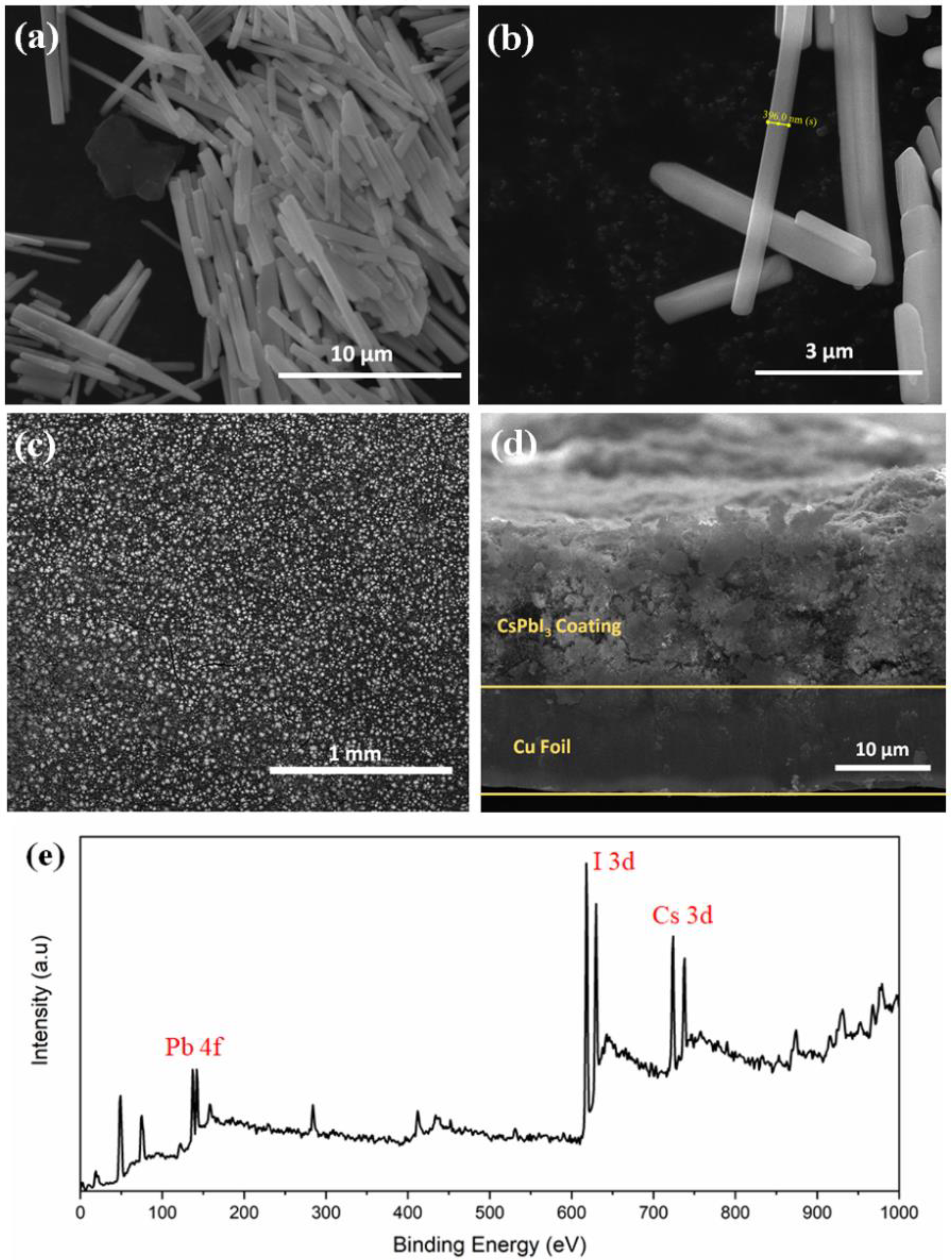
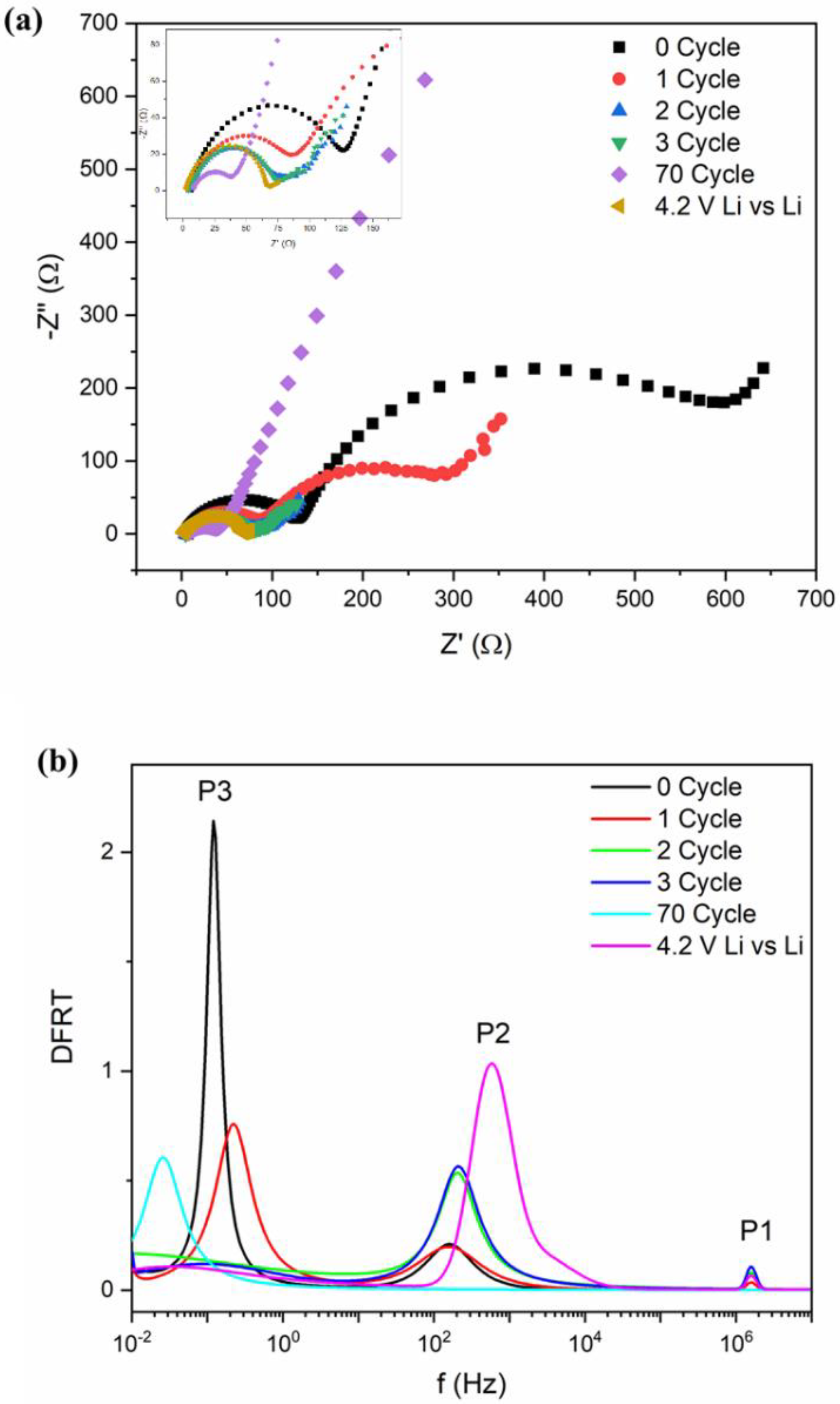

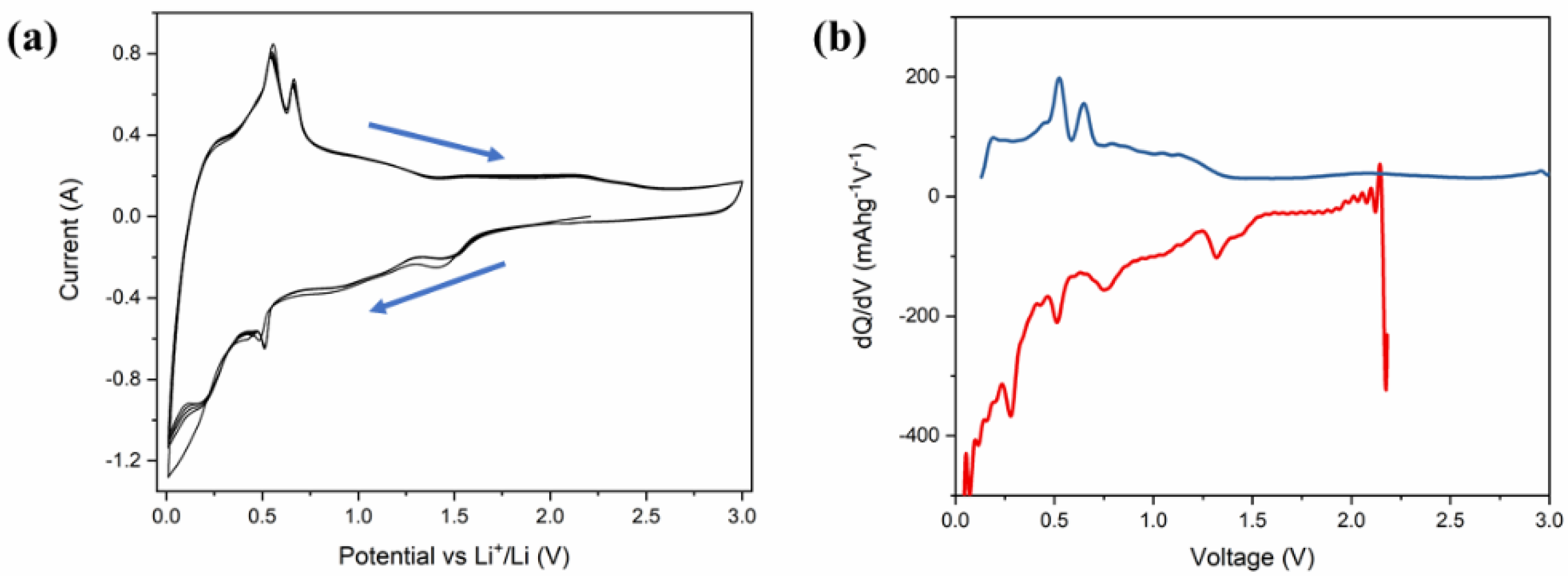
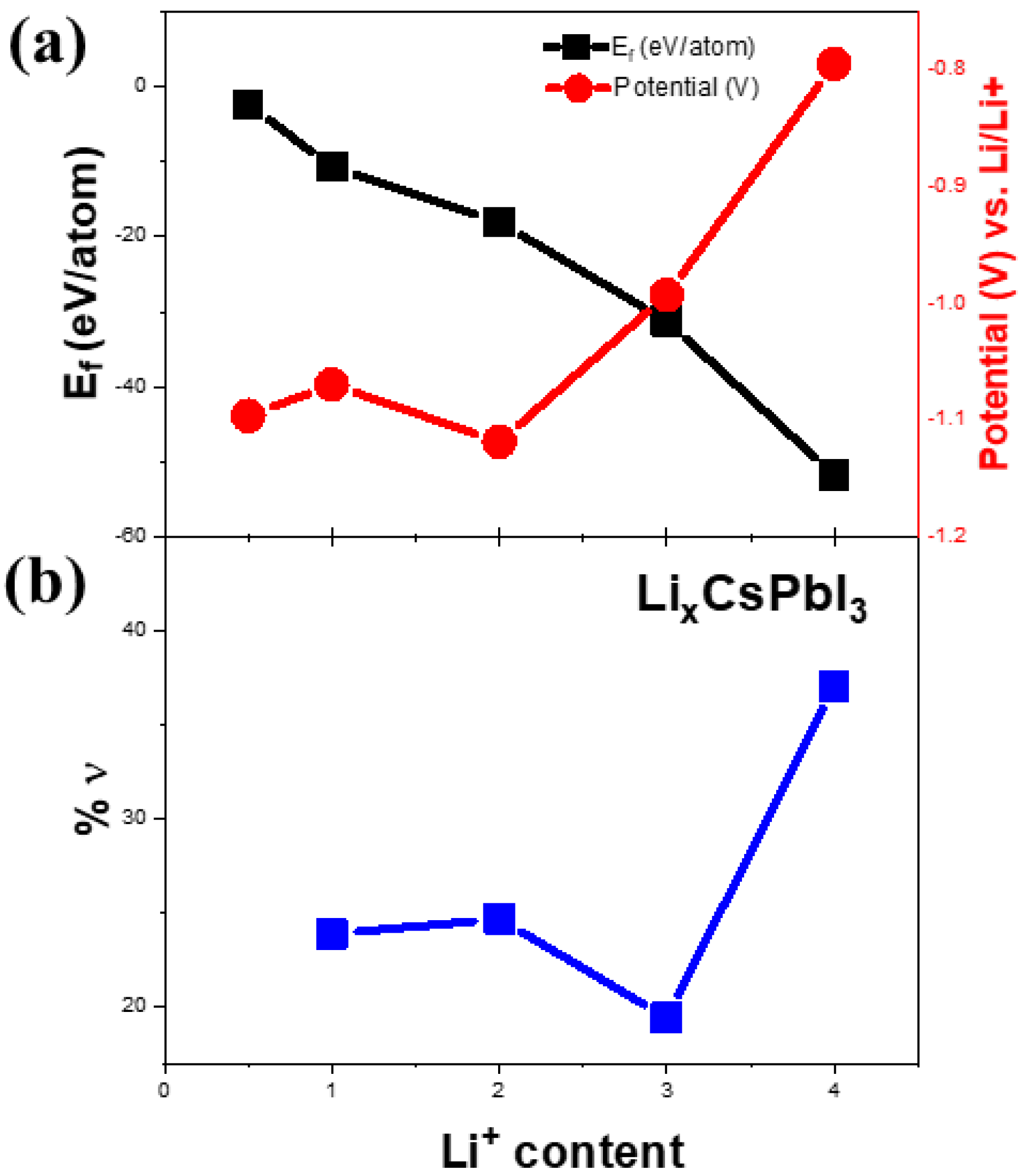
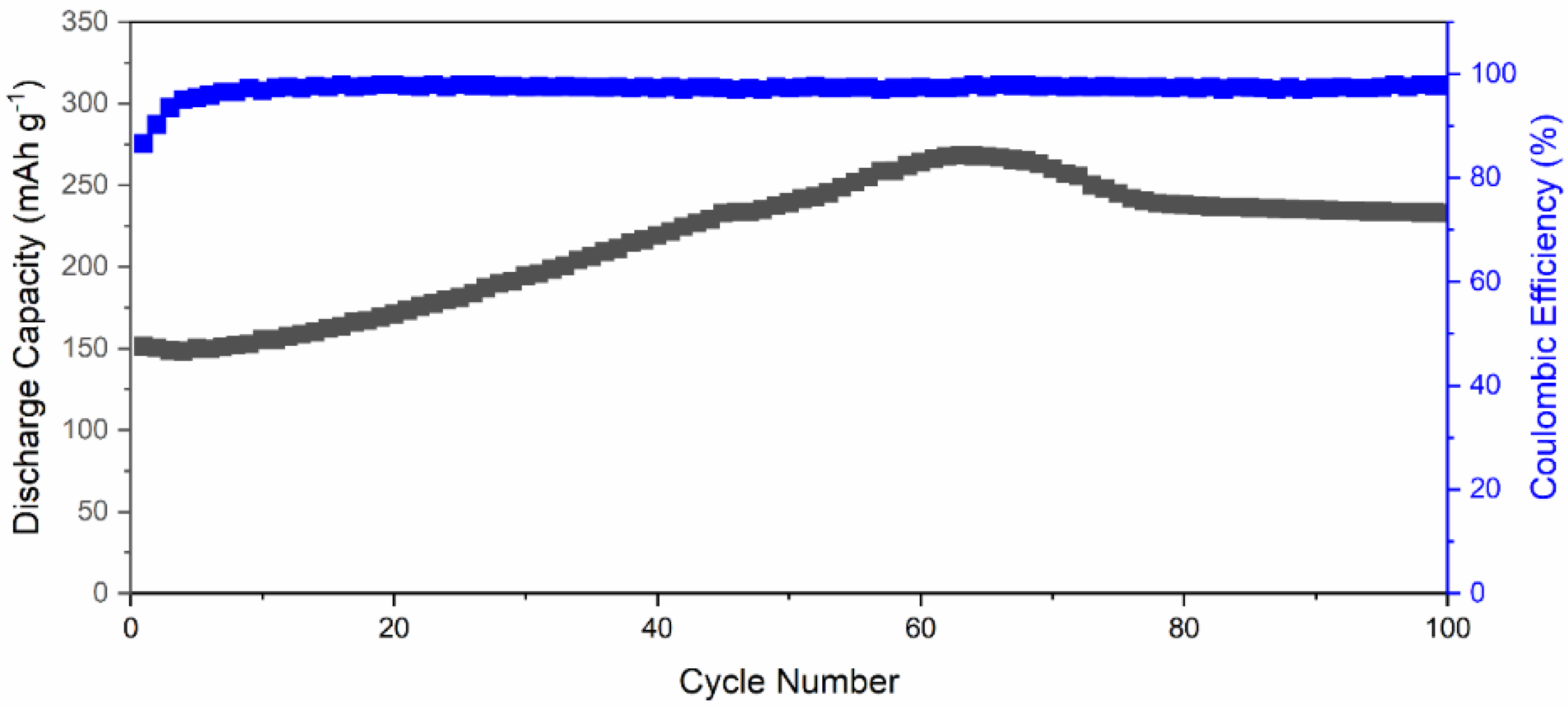
| Label of Atom | Atom | Wyckoff Site | Atomic Coordinates | Occupancy | ||
|---|---|---|---|---|---|---|
| x | y | z | ||||
| Pb | Pb | 4c | 0.16099 | 0.2500 | 0.43864 | 1 |
| I1 | I | 4c | 0.16396 | 0.2500 | 0.00343 | 0.995 |
| I2 | I | 4c | 0.29759 | 0.2500 | 0.28639 | 0.974 |
| I3 | I | 4c | 0.03533 | 0.2500 | 0.61563 | 1 |
| Cs | Cs | 4c | 0.41541 | 0.2500 | 0.66999 | 1 |
| Label of Atom | B11 | B22 | B33 | B12 | B13 | B23 |
|---|---|---|---|---|---|---|
| Pb | 0.00148 | 0.04421 | 0.00015 | 0 | 0.00088 | 0 |
| I1 | 0.00302 | 0.01320 | 0.00154 | 0 | 0.00173 | 0 |
| I2 | −0.00049 | 0.05040 | 0.00014 | 0 | 0.00023 | 0 |
| I3 | 0.00127 | 0.04586 | 0.00086 | 0 | −0.00028 | 0 |
| Cs | −0.00077 | 0.07601 | 0.00194 | 0 | 0.00076 | 0 |
Publisher’s Note: MDPI stays neutral with regard to jurisdictional claims in published maps and institutional affiliations. |
© 2021 by the authors. Licensee MDPI, Basel, Switzerland. This article is an open access article distributed under the terms and conditions of the Creative Commons Attribution (CC BY) license (https://creativecommons.org/licenses/by/4.0/).
Share and Cite
Kaisar, N.; Paul, T.; Chi, P.-W.; Su, Y.-H.; Singh, A.; Chu, C.-W.; Wu, M.-K.; Wu, P.M. Electrochemical Performance of Orthorhombic CsPbI3 Perovskite in Li-Ion Batteries. Materials 2021, 14, 5718. https://doi.org/10.3390/ma14195718
Kaisar N, Paul T, Chi P-W, Su Y-H, Singh A, Chu C-W, Wu M-K, Wu PM. Electrochemical Performance of Orthorhombic CsPbI3 Perovskite in Li-Ion Batteries. Materials. 2021; 14(19):5718. https://doi.org/10.3390/ma14195718
Chicago/Turabian StyleKaisar, Nahid, Tanmoy Paul, Po-Wei Chi, Yu-Hsun Su, Anupriya Singh, Chih-Wei Chu, Maw-Kuen Wu, and Phillip M. Wu. 2021. "Electrochemical Performance of Orthorhombic CsPbI3 Perovskite in Li-Ion Batteries" Materials 14, no. 19: 5718. https://doi.org/10.3390/ma14195718





